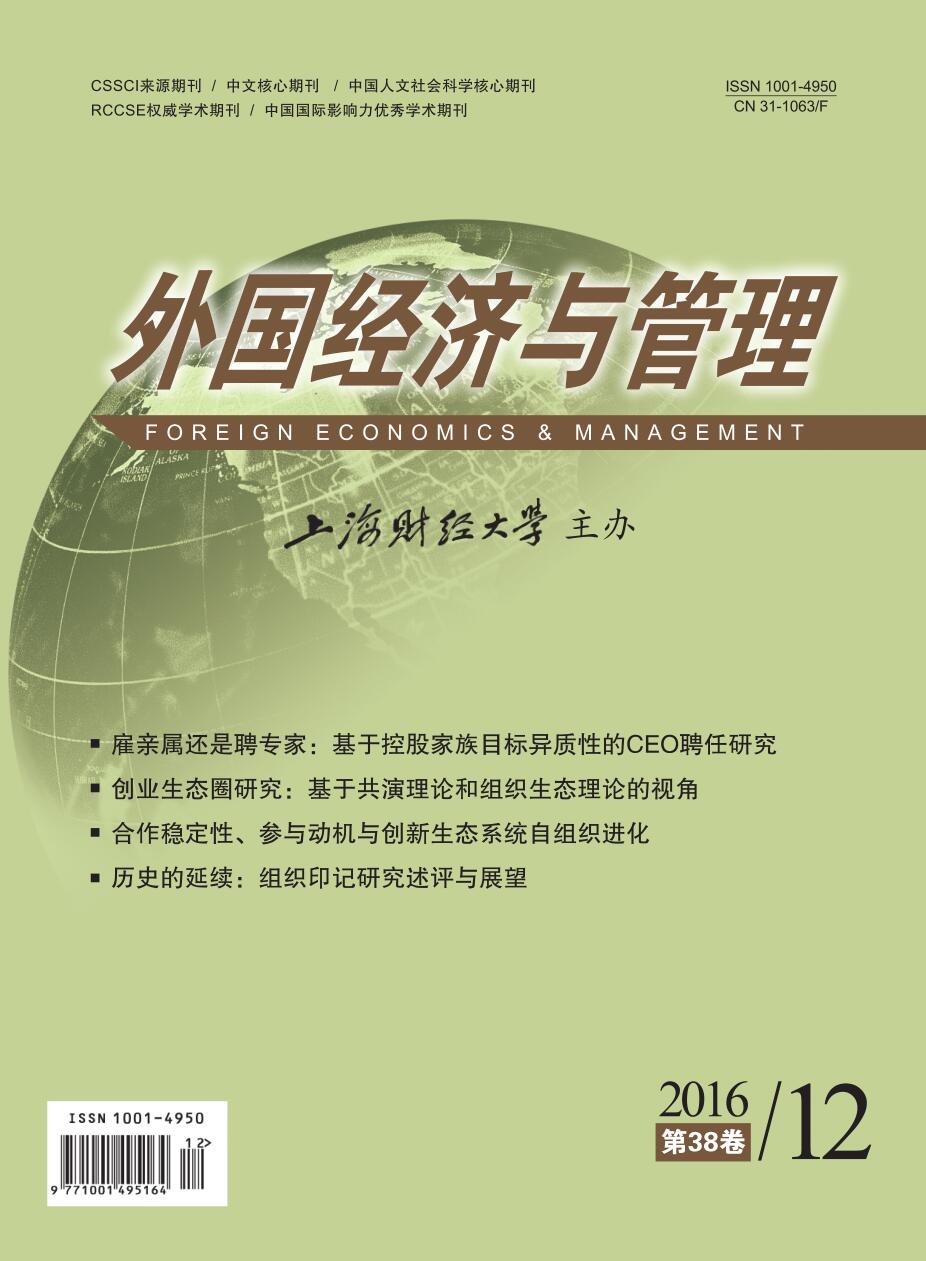历史是现实的重要解释变量,中国近代历史上的经济政治体制与当前现状相差悬殊,然而遗憾的是国内学术界对历史作用的关注并不充分。西方学术界,早在半个世纪前就诞生了理解历史对现实作用的重要概念——组织印记,研究组织成立时的条件对组织当前和未来产生的影响。本文遵循Stinchcombe的研究思路,综述了组织印记的概念,剖析了组织印记产生和固化作用并构建了系统动力学模型,总结了组织印记的作用领域,提出了组织印记研究对于中国情境的重要性及可能的研究机会。本文的学术贡献是:第一,系统地综述了组织印记理论,明确了组织印记对于中国管理学研究的重要性及迫切性;第二,识别了中国情境下组织印记的潜在研究方向。
历史的延续:组织印记研究述评与展望
摘要
参考文献
1 奥兹. 谢依. 网络产业经济学[M]. 上海:上海财经大学出版社, 2002.
3 普兰吉什维里. 定势问题讨论集[M]. 北京:科学出版社, 1959.
4 郑维敏. 正反馈[M]. 北京:清华大学出版社, 1998.
5 Bamford C E, Dean T J, McDougall P P. An examination of the impact of initial founding conditions and decisions upon the performance of new bank start-ups[J]. Journal of Business Venturing, 2000, 15(3):253-277. DOI:10.1016/S0883-9026(98)00011-1
6 Boeker W. Organizational origins:Entrepreneurial and environmental imprinting at the time of founding[A]. Carroll R G, Amos H. Ecological Models of Organizations[M]. Cambridge, MA:Ballinger, 1988:33-51.
7 Calori R, Lubatkin M, Very P, et al. Modelling the origins of nationally-bound administrative heritages:A historical institutional analysis of French and British firms[J]. Organization Science, 1997, 8(6):681-696. DOI:10.1287/orsc.8.6.681
8 Child J, Markóczy L. Host-country managerial behavior and learning in Chinese and Hungarian joint ventures[J]. Journal of Management Studies, 1993, 30(4):611-631. DOI:10.1111/joms.1993.30.issue-4
9 Cohen M D, Burkhart R, Dosi G. et al. Routines and other recurring action patterns of organizations:Contemporary research issues[J]. Industrial and Corporate Change, 1996, 5(3):665-698.
10 DiMaggio P J, Powell W W. The iron cage revisited:Institutional isomorphism and collective rationality in organizational fields[J]. American Sociological Review, 1983, 48(2):147-160. DOI:10.2307/2095101
12 Filatotchev I, Buck T, Zhukov V. Downsizing in privatized firms in Russia, Ukraine, and Belarus[J]. Academy of Management Journal, 2000, 43(3):286-304. DOI:10.2307/1556396
13 Greenwood R, Díaz A M, Li S X, et al. The multiplicity of institutional logics and the heterogeneity of organizational responses[J]. Organization Science, 2010, 21(2):521-539. DOI:10.1287/orsc.1090.0453
14 Han Y, Zheng E Y, Xu M Y. The influence from the past:Organizational imprinting and firms' compliance with social insurance policies in China[J]. Journal of Business Ethics, 2014, 122(1):65-77. DOI:10.1007/s10551-013-1758-3
15 Hannan M T, Freeman J. Structural inertia and organizational change[J]. American Sociological Review, 1984, 49(2):149-164. DOI:10.2307/2095567
16 Hsu D H, Lim K. Knowledge brokering and organizational innovation:Founder imprinting effects[J]. Organization Science, 2014, 25(4):1134-1153. DOI:10.1287/orsc.2013.0863
17 Immelmann K. Ecological significance of imprinting and early learning[J]. Annual Review of Ecology and Systematics, 1975, 6:15-37. DOI:10.1146/annurev.es.06.110175.000311
18 Johnson V. What is organizational imprinting? Cultural entrepreneurship in the founding of the Paris Opera[J]. American Journal of Sociology, 2007, 113(1):97-127. DOI:10.1086/517899
19 Jones G, Khanna T. Bringing history (back) into international business[J]. Journal of International Business Studies, 2006, 37(4):453-468. DOI:10.1057/palgrave.jibs.8400198
20 Joshi A, Dencker J C, Franz G, et al. Unpacking generational identities in organizations[J]. Academy of Management Review, 2010, 35(3):392-414. DOI:10.5465/AMR.2010.51141800
21 Kimberly J R, Bouchikhi H. The dynamics of organizational development and change:How the past shapes the present and constrains the future[J]. Organization Science, 1995, 6(1):9-18. DOI:10.1287/orsc.6.1.9
22 Kogut B. Learning, or the importance of being inert:Country imprinting and international competition[A]. Ghoshal S, Westney E. Organization Theory and the Multinational Corporation[M]. New York:St Martin's Press, 1993:136-154.
23 Kriauciunas A, Kale P. The impact of socialist imprinting and search on resource change:A study of firms in Lithuania[J]. Strategic Management Journal, 2006, 27(7):659-679. DOI:10.1002/(ISSN)1097-0266
24 Lant T K, Mezias S J. An organizational learning model of convergence and reorientation[J]. Organization Science, 1992, 3(1):47-71. DOI:10.1287/orsc.3.1.47
25 Leblebici H, Salancik G R, Copay A, et al. Institutional change and the transformation of interorganizational fields:An organizational history of the U. S. radio broadcasting industry[J]. Administrative Science Quarterly, 1991, 36(3):333-363. DOI:10.2307/2393200
26 Marquis C. The pressure of the past:Network imprinting in intercorporate communities[J]. Administrative Science Quarterly, 2003, 48(4):655-689. DOI:10.2307/3556640
27 Marquis C, Tilcsik A. Imprinting:Toward a multilevel theory[J]. The Academy of Management Annals, 2013, 7(1):195-245. DOI:10.1080/19416520.2013.766076
28 Mathias B D, Williams D W, Smith A R. Entrepreneurial inception:The role of imprinting in entrepreneurial action[J]. Journal of Business Venturing, 2015, 30(1):11-28. DOI:10.1016/j.jbusvent.2014.07.004
30 Park S H, Luo Y D. Guanxi and organizational dynamics:Organizational networking in Chinese firms[J]. Strategic Management Journal, 2001, 22(5):455-477. DOI:10.1002/(ISSN)1097-0266
31 Peng M W. Institutional transitions and strategic choices[J]. Academy of Management Review, 2003, 28(2):275-296.
32 Pentland B T, Rueter H H. Organizational routines as grammars of action[J]. Administrative Science Quarterly, 1994, 39(4):484-510.
33 Phillips D J. Organizational genealogies and the persistence of gender inequality:The case of Silicon Valley law firms[J]. Administrative Science Quarterly, 2005, 50(3):440-472. DOI:10.2189/asqu.2005.50.3.440
34 Shinkle G A, Kriauciunas A P. The impact of current and founding institutions on strength of competitive aspirations in transition economies[J]. Strategic Management Journal, 2012, 33(4):448-458. DOI:10.1002/smj.v33.4
35 Sørensen J B, Stuart T E. Aging, obsolescence, and organizational innovation[J]. Administrative Science Quarterly, 2000, 45(1):81-112. DOI:10.2307/2666980
36 Tilcsik A. Imprint-environment fit and performance:How organizational munificence at the time of hire affects subsequent job performance[J]. Administrative Science Quarterly, 2014, 59(4):639-668. DOI:10.1177/0001839214549042
37 White S, Linden G. Organizational and industrial response to market liberalization:The interaction of pace, incentive and capacity to change[J]. Organization Studies, 2002, 23(6):917-948. DOI:10.1177/0170840602236013
39 Zhou K Z, Tse D K, Li J J. Organizational changes in emerging economies:Drivers and consequences[J]. Journal of International Business Studies, 2006, 37(2):248-263. DOI:10.1057/palgrave.jibs.8400186
引用本文
王砚羽, 谢伟. 历史的延续:组织印记研究述评与展望[J]. 外国经济与管理, 2016, 38(12): 91–102.
导出参考文献,格式为:
下一篇:道义公平研究述评与展望






 16163
16163  10114
10114

